Comparative Performance of a Field-Based Assessment of Human Thermal Comfort Indices in Urban Green Space
Abstract
:1. Introduction
2. Materials and Methods
2.1. Study Area
2.2. Sample Region
2.3. Experimental Data
2.4. Evaluation of Human Comfort and Data Analysis
2.5. Model Validation
3. Results
3.1. Variations in Meteorological Factors Among Urban Green Space Types
3.1.1. Variations in Air Temperature Among Urban Green Space Types
3.1.2. Variations in Relative Humidity Among Urban Green Space Types
3.1.3. Variations in Wind Speed Among Urban Green Space Types
3.2. Comparison of Two Different Human Comfort Indices
3.2.1. Seasonal and Daily Variation in HCILU
3.2.2. Seasonal and Daily Variation in HCICMA
3.3. Factor Analysis of Two Human Comfort Formulas
3.4. A Comparative Analysis of Two Methods for Assessing Human Comfort
4. Discussion
5. Conclusions
Author Contributions
Funding
Institutional Review Board Statement
Informed Consent Statement
Data Availability Statement
Acknowledgments
Conflicts of Interest
References
- Givoni, B.; Noguchi, M.; Saaroni, H.; Pochter, O.; Yaacov, Y.; Feller, N.; Becker, S. Outdoor comfort research issues. Energy Build. 2003, 35, 77–86. [Google Scholar] [CrossRef]
- Nikolopoulou, M.; Lykoudis, S. Use of outdoor spaces and microclimate in a Mediterranean urban area. Build. Environ. 2007, 42, 3691–3707. [Google Scholar] [CrossRef]
- Yan, Y.C.; Yue, S.P.; Liu, X.H.; Wang, D.D.; Chen, H. Advances in assessment of bioclimatic comfort conditions at home and abroad. Adv. Earth Sci. 2013, 28, 1119–1125. [Google Scholar]
- Wang, Y.; Bakker, F.; De Groot, R.; Wörtche, H. Effect of ecosystem services provided by urban green infrastructure on indoor environment: A literature review. Build. Environ. 2014, 77, 88–100. [Google Scholar] [CrossRef]
- Breuste, J.; Artmann, M.; Li, J.; Xie, M. Special issue on green infrastructure for urban sustainability. J. Urban Plan. Dev. 2015, 141, A2015001. [Google Scholar] [CrossRef]
- Flohr, T.; Heris, M.; Derycke, E. An ENVI-met Simulation Data Pipeline for Evaluating Urban Tree Patterns Impact on Urban Micro-climate. J. Digit. Landsc. Archit. 2022, 2022, 538–548. [Google Scholar]
- Coccolo, S.; Kämpf, J.; Scartezzini, J.; Pearlmutter, D. Outdoor human comfort and thermal stress: A comprehensive review on models and standards. Urban Clim. 2016, 18, 33–57. [Google Scholar] [CrossRef]
- Javadi, R.; Nasrollahi, N. Urban green space and health: The role of thermal comfort on the health benefits from the urban green space; a review study. Build. Environ. 2021, 202, 108039. [Google Scholar] [CrossRef]
- Wang, Y.; Bakker, F.; de Groot, R.; Wörtche, H.; Leemans, R. Effects of urban green infrastructure (UGI) on local outdoor microclimate during the growing season. Environ. Monit. Assess. 2015, 187, 732. [Google Scholar] [CrossRef]
- Quadros, B.M.; Mizgier, M.G.O. Urban green infrastructures to improve pedestrian thermal comfort: A systematic review. Urban For. Urban Green. 2023, 88, 128091. [Google Scholar] [CrossRef]
- Lin, T.; Matzarakis, A.; Hwang, R. Shading effect on long-term outdoor thermal comfort. Build. Environ. 2010, 45, 213–221. [Google Scholar] [CrossRef]
- Yu, G.; Schwartz, Z.; Walsh, J.E. A weather-resolving index for assessing the impact of climate change on tourism related climate resources. Clim. Change 2009, 95, 551–573. [Google Scholar] [CrossRef]
- Yau, Y.H.; Toh, H.S.; Chew, B.T.; Nik Ghazali, N.N. A review of human thermal comfort model in predicting human–environment interaction in non-uniform environmental conditions. J. Therm. Anal. Calorim. 2022, 147, 14739–14763. [Google Scholar] [CrossRef] [PubMed]
- Park, M.; Hagishima, A.; Tanimoto, J.; Narita, K. Effect of urban vegetation on outdoor thermal environment: Field measurement at a scale model site. Build. Environ. 2012, 56, 38–46. [Google Scholar] [CrossRef]
- Coccolo, S.; Mauree, D.; Naboni, E.; Kaempf, J.; Scartezzini, J.L. On the impact of the wind speed on the outdoor human comfort: A sensitivity analysis. Energy Procedia 2017, 122, 481–486. [Google Scholar] [CrossRef]
- Cohen, P.; Potchter, O.; Matzarakis, A. Daily and seasonal climatic conditions of green urban open spaces in the Mediterranean climate and their impact on human comfort. Build. Environ. 2012, 51, 285–295. [Google Scholar] [CrossRef]
- Lin, J.; Kroll, C.N.; Nowak, D.J.; Greenfield, E.J. A review of urban forest modeling: Implications for management and future research. Urban For. Urban Green. 2019, 43, 126366. [Google Scholar] [CrossRef]
- Al-Saadi, L.M.; Jaber, S.H.; Al-Jiboori, M.H. Variation of urban vegetation cover and its impact on minimum and maximum heat islands. Urban Clim. 2020, 34, 100707. [Google Scholar] [CrossRef]
- Sodoudi, S.; Zhang, H.; Chi, X.; Müller, F.; Li, H. The influence of spatial configuration of green areas on microclimate and thermal comfort. Urban For. Urban Green. 2018, 34, 85–96. [Google Scholar] [CrossRef]
- Sun, F.; Zhang, J.; Takeda, S.; Cui, J.; Yang, R. Vertical Plant Configuration: Its Impact on Microclimate and Thermal Comfort in Urban Small Green Spaces. Land 2024, 13, 1715. [Google Scholar] [CrossRef]
- Xu, H.; Zheng, G.; Lin, X.; Jin, Y. Study on the Microclimatic Effects of Plant-Enclosure Conditions and Water–Green Space Ratio on Urban Waterfront Spaces in Summer. Sustainability 2024, 16, 2957. [Google Scholar] [CrossRef]
- Lu, D.H.; Wu, Z.W.; Zhang, Q.Q.; Li, L.; Yu, G.H.; Gong, H.N. Benefits of Zhang Jia Jie national forest park. J. Cent.-South For. Coll. 1985, 2, 160–170. [Google Scholar]
- Yao, X.; Zhang, M.; Zhang, Y.; Xiao, H.; Wang, J. Research on evaluation of climate comfort in northwest China under climate change. Sustainability 2021, 13, 10111. [Google Scholar] [CrossRef]
- Liu, Q.; Lin, L.; Deng, H.; Zheng, Y.; Hu, Z. The index of clothing for assessing tourism climate comfort: Development and application. Front. Environ. Sci. 2023, 10, 992503. [Google Scholar] [CrossRef]
- QX/T570-2020; Climate Resource Assessment-Climate Livable Cities. China Meteorological Administration: Beijing, China, 2020.
- Satir, O.; Berberoglu, S.; Donmez, C. Mapping regional forest fire probability using artificial neural network model in a Mediterranean forest ecosystem. Geomat. Nat. Hazards Risk 2016, 7, 1645–1658. [Google Scholar] [CrossRef]
- Greiner, M.; Pfeiffer, D.; Smith, R.D. Principles and practical application of the receiver-operating characteristic analysis for diagnostic tests. Prev. Vet. Med. 2000, 45, 23–41. [Google Scholar] [CrossRef]
- Ali, S.B.; Patnaik, S. Thermal comfort in urban open spaces: Objective assessment and subjective perception study in tropical city of Bhopal, India. Urban Clim. 2018, 24, 954–967. [Google Scholar] [CrossRef]
- de Abreu-Harbich, L.V.; Labaki, L.C.; Matzarakis, A. Effect of tree planting design and tree species on human thermal comfort in the tropics. Landsc. Urban Plan 2015, 138, 99–109. [Google Scholar] [CrossRef]
- Nicol, F. Adaptive thermal comfort standards in the hot–humid tropics. Energy Build. 2004, 36, 628–637. [Google Scholar] [CrossRef]
- Lai, D.; Liu, Y.; Liao, M.; Yu, B. Effects of different tree layouts on outdoor thermal comfort of green space in summer Shanghai. Urban Clim. 2023, 47, 101398. [Google Scholar] [CrossRef]
- Johansson, E.; Emmanuel, R. The influence of urban design on outdoor thermal comfort in the hot, humid city of Colombo, Sri Lanka. Int. J. Biometeorol. 2006, 51, 119–133. [Google Scholar] [CrossRef] [PubMed]
- Walton, D.; Dravitzki, V.; Donn, M. The relative influence of wind, sunlight and temperature on user comfort in urban outdoor spaces. Build. Environ. 2007, 42, 3166–3175. [Google Scholar] [CrossRef]
- Ghasemi, Z.; Esfahani, M.A.; Bisadi, M. Promotion of urban environment by consideration of human thermal & wind comfort: A literature review. Procedia-Soc. Behav. Sci. 2015, 201, 397–408. [Google Scholar]
- Penwarden, A.D. Acceptable wind speeds in towns. Build. Sci. 1973, 8, 259–267. [Google Scholar] [CrossRef]
- Andrade, H.; Alcoforado, M.; Oliveira, S. Perception of temperature and wind by users of public outdoor spaces: Relationships with weather parameters and personal characteristics. Int. J. Biometeorol. 2011, 55, 665–680. [Google Scholar] [CrossRef]
- Minjie, D.; Yuerong, W.; Jing, L. Comprehensive evaluation of ecological health functions of green space in Beijing Purple Bamboo Park. Chin. J. Ecol. 2017, 36, 1973–1983. [Google Scholar]
- Quan, M.; Wu, J.; Nan, H.; Gong, M. Study on the Effect of Physical and Mental Health on Different Forest Environments in Summer. Adv. Psychol. 2020, 10, 886–896. [Google Scholar] [CrossRef]
- Movahedi, F.; Padman, R.; Antaki, J.F. Limitations of receiver operating characteristic curve on imbalanced data: Assist device mortality risk scores. J. Thorac. Cardiovasc. Surg. 2023, 165, 1433–1442. [Google Scholar] [CrossRef]
- Majnik, M.; Bosnić, Z. ROC analysis of classifiers in machine learning: A survey. Intell. Data Anal. 2013, 17, 531–558. [Google Scholar] [CrossRef]
- Fawcett, T. An introduction to ROC analysis. Pattern Recognit. Lett. 2006, 27, 861–874. [Google Scholar] [CrossRef]
- Perini, K.; Magliocco, A. Effects of vegetation, urban density, building height, and atmospheric conditions on local temperatures and thermal comfort. Urban For. Urban Green. 2014, 13, 495–506. [Google Scholar] [CrossRef]
- He, S.; Zhang, C.; Meng, F.; Bourque, C.P.; Huang, Z.; Li, X.; Han, Y.; Feng, S.; Miao, L.; Liu, C. Vegetation-cover control of between-site soil temperature evolution in a sandy desertland. Sci. Total Environ. 2024, 908, 168372. [Google Scholar] [CrossRef] [PubMed]
- Jiang, J.; Irga, P.; Coe, R.; Gibbons, P. Effects of indoor plants on CO2 concentration, indoor air temperature and relative humidity in office buildings. PLoS ONE 2024, 19, e305956. [Google Scholar] [CrossRef] [PubMed]
- Mohamed, N.E.; Mustafa, A.A.; Bedawy, I.M.; Ahmed, A.S.; Abdelsamie, E.A.; Mohamed, E.S.; Rebouh, N.Y.; Shokr, M.S. Utilizing Infrared Thermometry to Assess the Crop Water Stress Index of Wheat Genotypes in Arid Regions under Varying Irrigation Regimes. Agronomy 2024, 14, 1814. [Google Scholar] [CrossRef]
- Lopez-Cabeza, V.P.; Loor-Vera, M.J.; Diz-Mellado, E.; Rivera-Gomez, C.; Galan-Marin, C. Decoding outdoor thermal comfort: The role of location in urban canyon microclimate. Sustain. Energy Technol. Assess. 2024, 72, 104095. [Google Scholar] [CrossRef]
- Zhang, L.; Zhan, Q.; Lan, Y. Effects of the tree distribution and species on outdoor environment conditions in a hot summer and cold winter zone: A case study in Wuhan residential quarters. Build. Environ. 2018, 130, 27–39. [Google Scholar] [CrossRef]
- Zhang, S.; Yuan, W.; Yu, Y.; Zhang, Y.; Wang, W.; Wang, L.; Yang, Y.; Wang, H. Shrubs plays an important role in configuration of shelterbelt in windy and sandy areas. Front. Ecol. Evol. 2024, 12, 1347714. [Google Scholar] [CrossRef]
- Butenschoen, O.; Scheu, S.; Eisenhauer, N. Interactive effects of warming, soil humidity and plant diversity on litter decomposition and microbial activity. Soil Biol. Biochem. 2011, 43, 1902–1907. [Google Scholar] [CrossRef]
- Zhang, Z.; Lv, Y.; Pan, H. Cooling and humidifying effect of plant communities in subtropical urban parks. Urban For. Urban Green. 2013, 12, 323–329. [Google Scholar] [CrossRef]
- Pan, J.B.; Dong, L. Evaluation of air negative ions concentration in urban green space:A case study in Beijing Olympic Forest Park. Chin. J. Ecol. 2010, 29, 1881–1886. [Google Scholar]
- Ganot, Y.; Dragila, M.I.; Weisbrod, N. Impact of thermal convection on air circulation in a mammalian burrow under arid conditions. J. Arid Environ. 2012, 84, 51–62. [Google Scholar] [CrossRef]
- Lydia, M.; Kumar, S.S.; Selvakumar, A.I.; Kumar, G.E.P. Linear and non-linear autoregressive models for short-term wind speed forecasting. Energy Convers. Manag. 2016, 112, 115–124. [Google Scholar] [CrossRef]
- Song, Y.; Mao, F.; Liu, Q. Human comfort in indoor environment: A review on assessment criteria, data collection and data analysis methods. IEEE Access 2019, 7, 119774–119786. [Google Scholar] [CrossRef]
- Su, X.; Yuan, Y.; Wang, Z.; Liu, W.; Lan, L.; Lian, Z. Human thermal comfort in non-uniform thermal environments: A review. Energy Built Environ. 2024, 5, 853–862. [Google Scholar] [CrossRef]
- Nakamura, M.; Yoda, T.; Crawshaw, L.I.; Yasuhara, S.; Saito, Y.; Kasuga, M.; Nagashima, K.; Kanosue, K. Regional differences in temperature sensation and thermal comfort in humans. J. Appl. Physiol. 2008, 105, 1897–1906. [Google Scholar] [CrossRef]
- Lucena, R.L.; de Freitas Santos, T.H.; Ferreira, A.M.; Steinke, E.T. Heat and human comfort in a town in Brazil’s semi-arid region. Int. J. Clim. Chang. Impacts Responses 2016, 8, 15. [Google Scholar] [CrossRef]
- Li, J.; Zhou, K.; Zhang, D.; Pubu, D.; Zhang, W.; Shi, J. Spatial and temporal variation characteristics of comfort index of human body in Xizang Plateau. Arid Land Geogr. 2024, 47, 980–992. [Google Scholar]
- Pantavou, K.; Lykoudis, S.; Nikolopoulou, M.; Tsiros, I.X. Correction to: Thermal sensation and climate: A comparison of UTCI and PET thresholds in different climates. Int. J. Biometeorol. 2020, 64, 301. [Google Scholar] [CrossRef]
- Aghamolaei, R.; Azizi, M.M.; Aminzadeh, B.; O Donnell, J. A comprehensive review of outdoor thermal comfort in urban areas: Effective parameters and approaches. Energy Environ. 2023, 34, 2204–2227. [Google Scholar] [CrossRef]
- Shooshtarian, S.; Lam, C.K.C.; Kenawy, I. Outdoor thermal comfort assessment: A review on thermal comfort research in Australia. Build. Environ. 2020, 177, 106917. [Google Scholar] [CrossRef]
- Yang, Z.; Zhang, W.; Qin, M.; Liu, H. Comparative study of indoor thermal environment and human thermal comfort in residential buildings among cities, towns, and rural areas in arid regions of China. Energy Build. 2022, 273, 112373. [Google Scholar] [CrossRef]
- Lei, Y.N.; Zhang, X.; Zhao, X.M. Spatial-temporal distribution characteristics of comfort index of human body in Shaanxi Province from 1971 to 2018. Arid Land Geogr. 2020, 43, 1417–1425. [Google Scholar]
- Zheng, Q.Z.; He, J.; Li, S.Z.; Deng, C.Z.; Wu, Z.P.; Huang, X.L.; Wu, X. Analysis on the differences and influencing factors of human comfort between urban and rural areas in Chongqing. Ecol. Environ. Sci. 2023, 32, 1089–1097. [Google Scholar]
- Chen, L.; Yan, F.; Fan, S.; Wu, Y.; Yang, J.; Yang, H.; Huang, C. The effects of short-term light exposure on subjective affect and comfort are dependent on the lighting time of day. Sci. Rep. 2021, 11, 2604. [Google Scholar] [CrossRef]
- Xu, M.; Hong, B.; Mi, J.; Yan, S. Outdoor thermal comfort in an urban park during winter in cold regions of China. Sustain. Cities Soc. 2018, 43, 208–220. [Google Scholar] [CrossRef]
- Feng, S.H.; Gong, D.Y.; Zhang, Z.Y.; He, X.Z.; Guo, D.; Lei, Y.N. Wind-Chill Temperature Changes in Winter over China during the Last 50 Years. Acta Geogr. Sin. 2009, 64, 1071–1082. [Google Scholar]
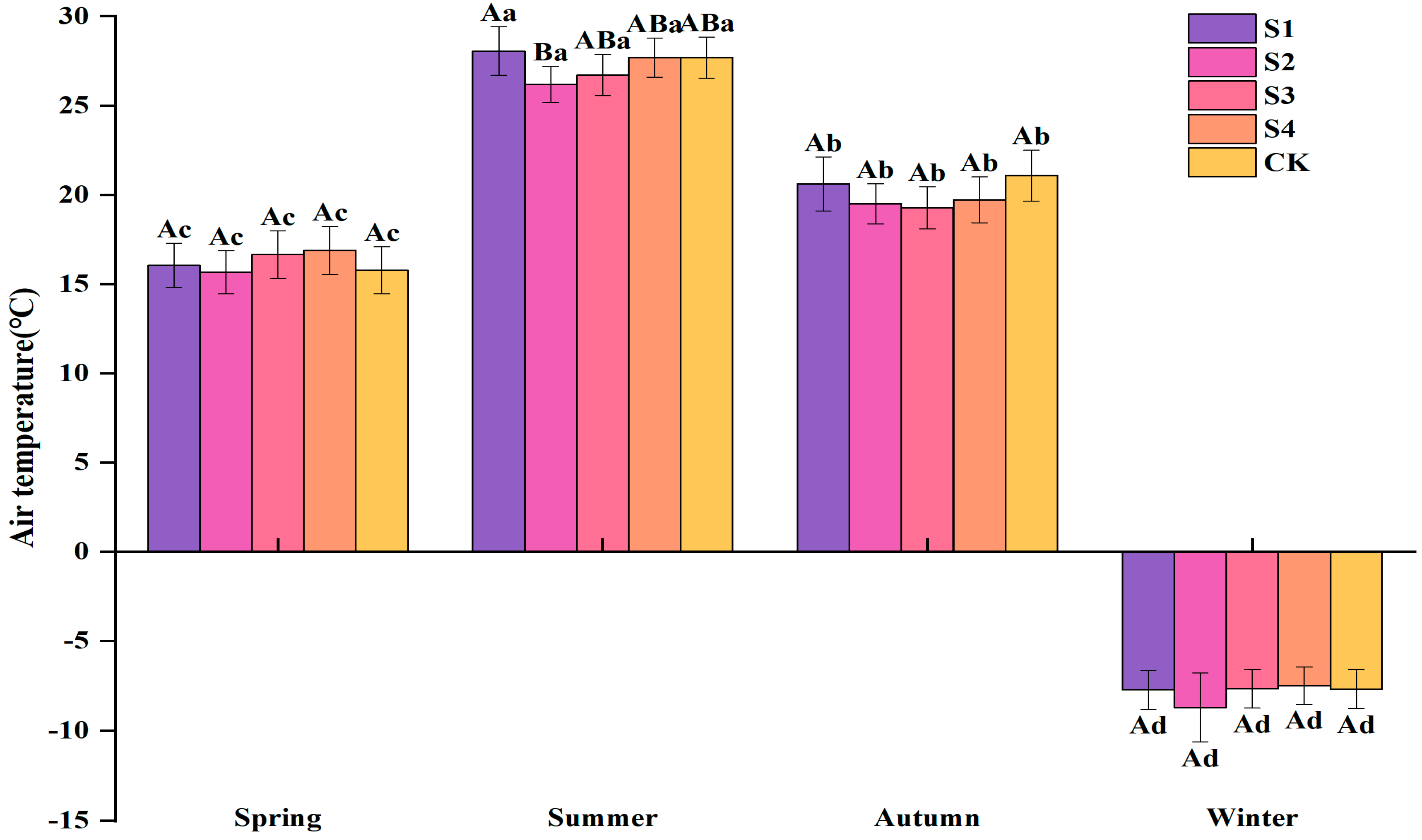
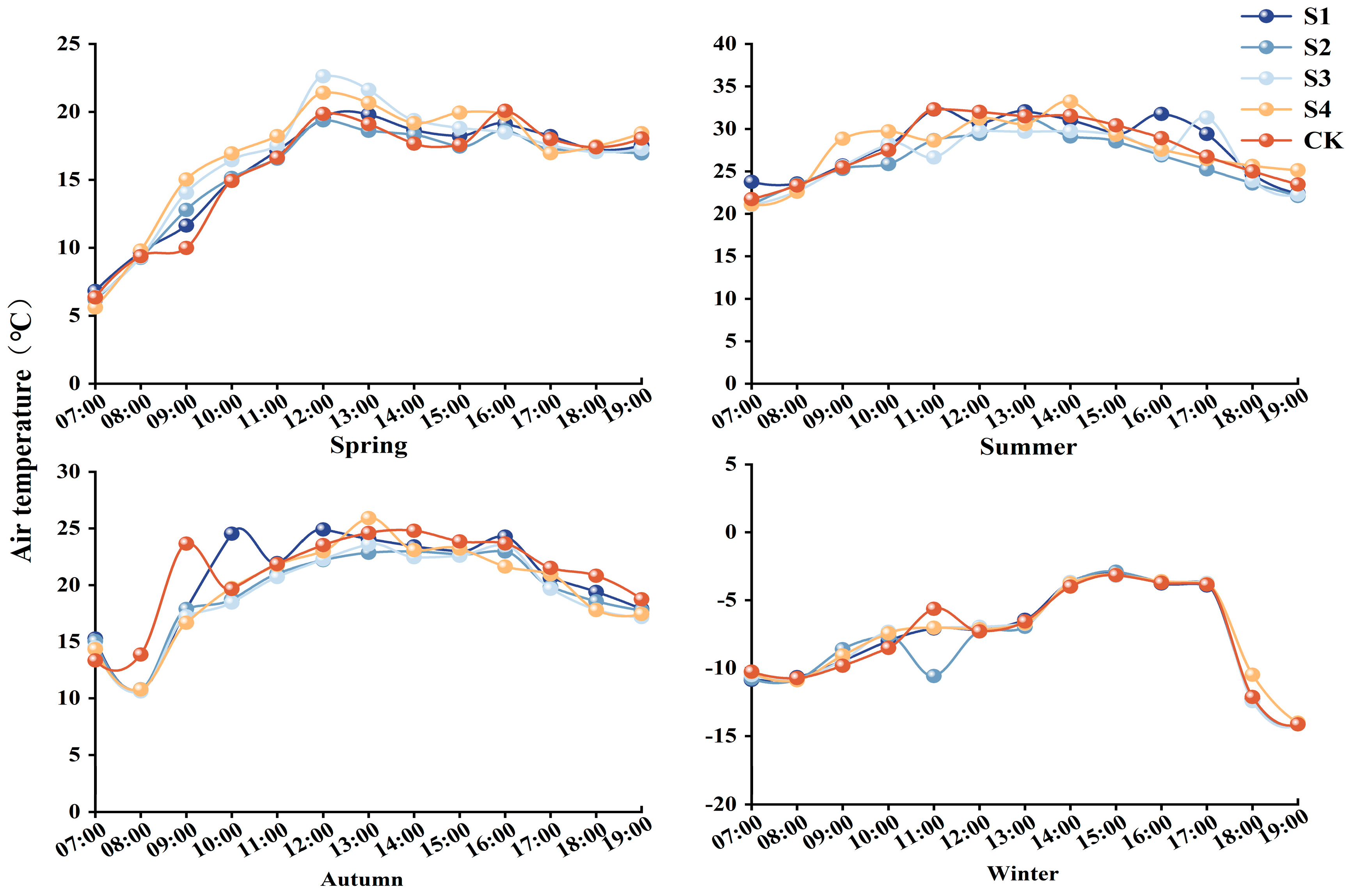
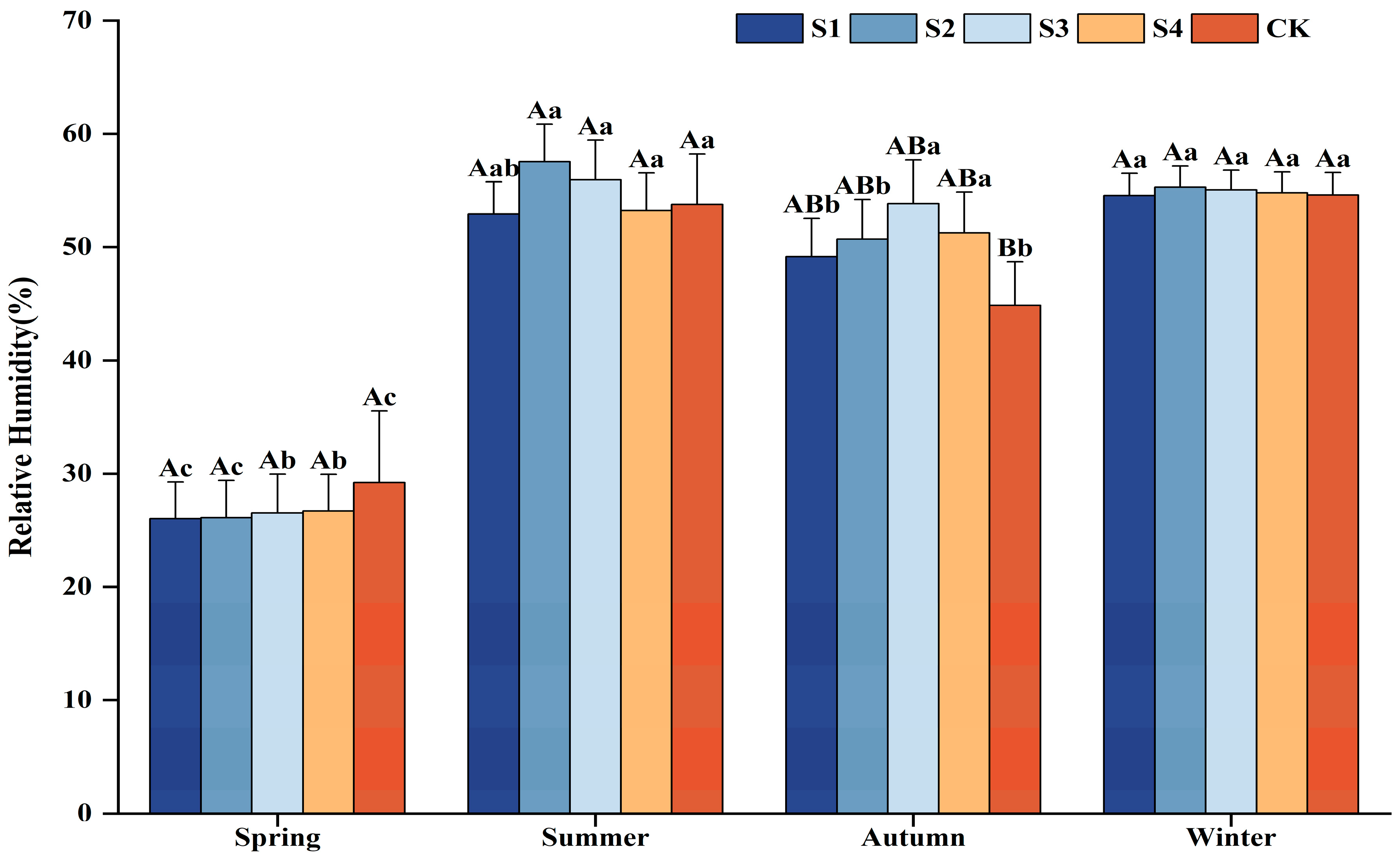


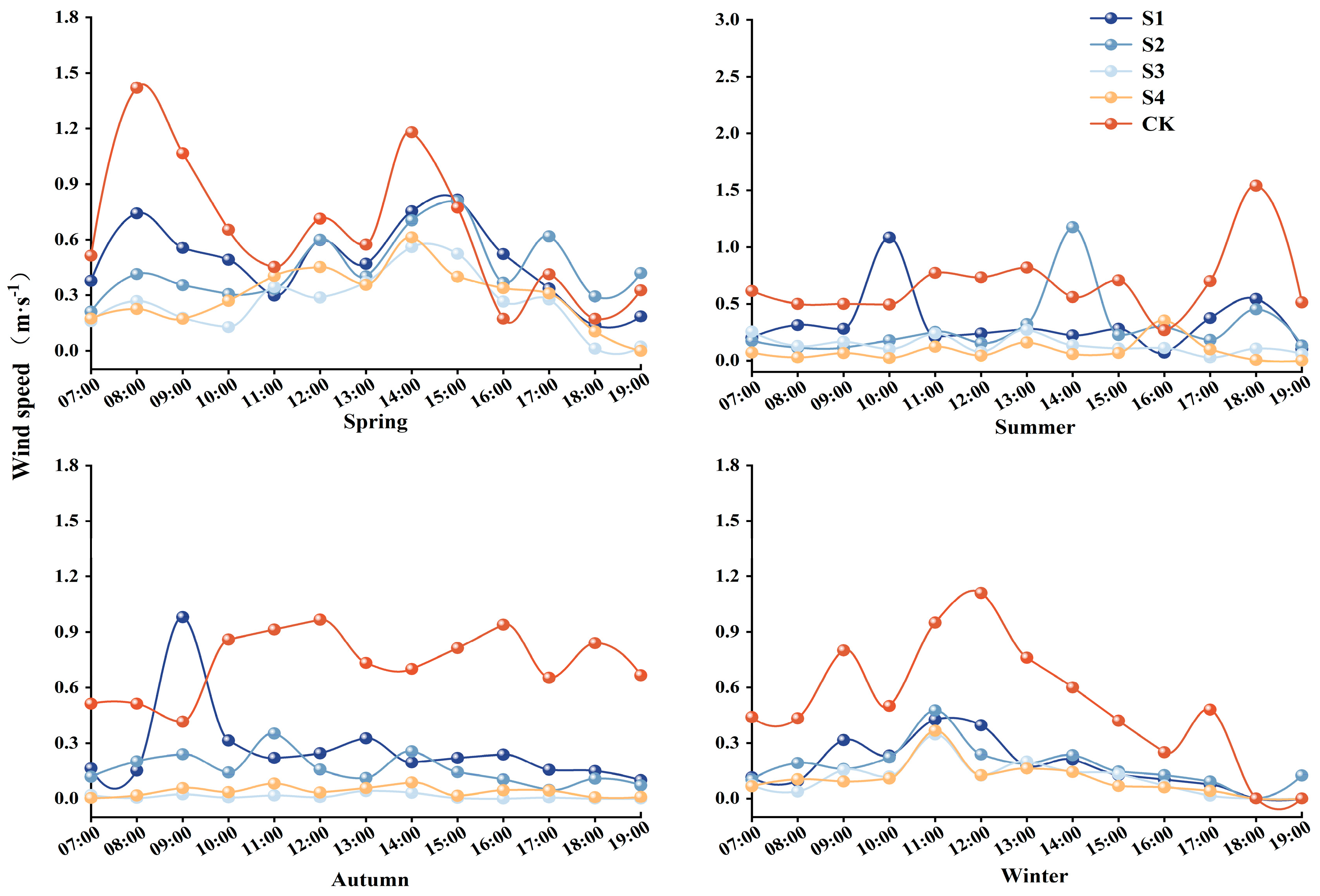
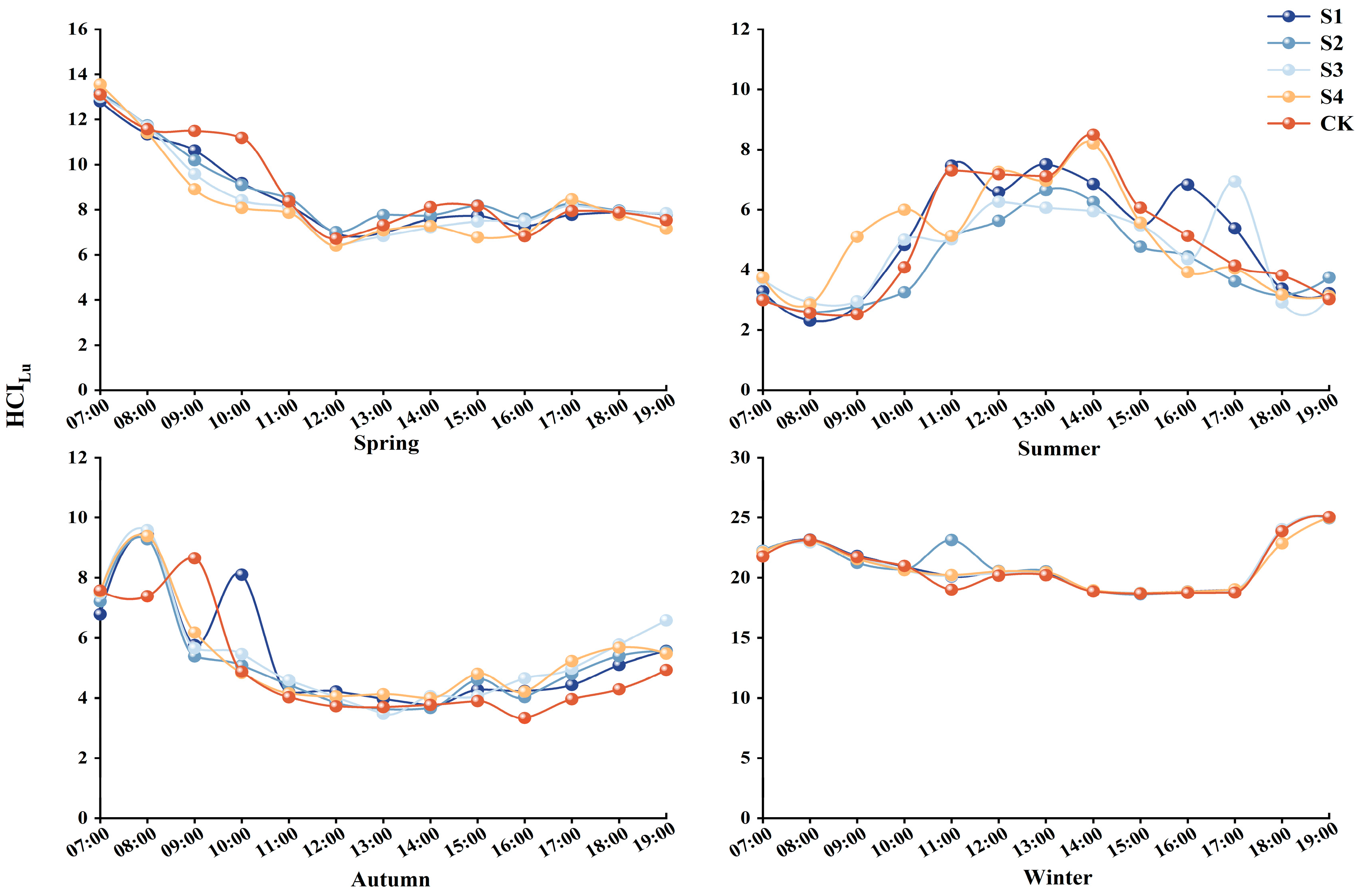
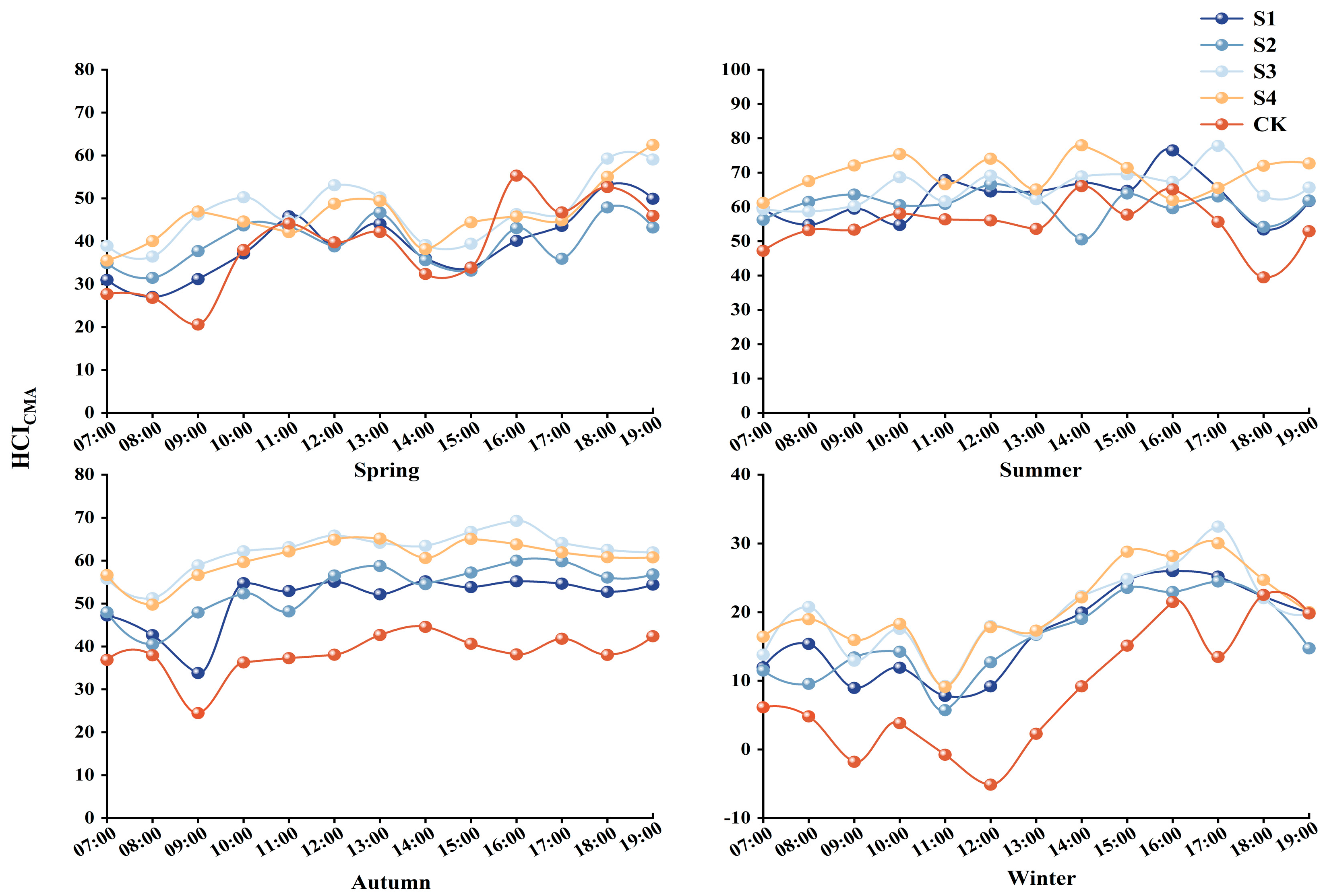
| Types of Urban Green Space | Dominant Plant Species | Mean Height (m) | Mean DBH (cm) |
|---|---|---|---|
| Deciduous broad-leaved sparse forest (S1) | Fraxinus chinensis | 5.2 ± 0.37 | 17.5 ± 0.65 |
| Prunus cerasifera ‘Atropurpurea’ | 2.7 ± 0.33 | 10.3 ± 0.62 | |
| Sophora japonica Linn. | 6.1 ± 0.28 | 13.6 ± 0.55 | |
| Catalpa ovata | 6.2 ± 0.22 | 15.4 ± 0.54 | |
| Sophora japonica Linn. | 6.7 ± 0.38 | 18.8 ± 0.46 | |
| Deciduous broad-leaved dense forest (S2) | Fraxinus chinensis | 5.2 ± 0.37 | 17.5 ± 0.65 |
| Euonymus maackii | 2.4 ± 0.31 | 4.5 ± 0.21 | |
| Prunus cerasifera ‘Atropurpurea’ | 2.7 ± 0.33 | 7.3 ± 0.22 | |
| Sophora japonica Linn. | 6.1 ± 0.28 | 10.5 ± 0.14 | |
| Ulmus pumila | 5.9 ± 0.38 | 17.7 ± 0.21 | |
| Salix matsudana | 8.9 ± 0.31 | 16.3 ± 0.22 | |
| Malus spectabilis | 2.9 ± 0.35 | 8.5 ± 0.14 | |
| Deciduous broad-leaved and evergreen needle dense mixed forest (S3) | Fraxinus chinensis | 5.2 ± 0.37 | 17.5 ± 0.65 |
| Styphnolobium japonicum Linn. | 6.1 ± 0.28 | 10.5 ± 0.14 | |
| Catalpa ovata | 6.2 ± 0.22 | 15.4 ± 0.54 | |
| Ulmus pumila | 5.9 ± 0.38 | 17.7 ± 0.21 | |
| Populus alba var. pyramidalis | 15.9 ± 0.31 | 24.5 ± 0.19 | |
| Firmiana simplex (Linnaeus) | 8.9 ± 0.31 | 31.5 ± 0.24 | |
| Salix matsudana | 2.4 ± 0.32 | 16.5 ± 0.23 | |
| Prunus padus | 4.6 ± 0.28 | 21.5 ± 0.17 | |
| Betula platyphylla | 10.9 ± 0.33 | 22.5 ± 0.17 | |
| Juniperus chinensis | 9.1 ± 0.41 | 25.5 ± 0.25 | |
| Picea asperata Mast. | 11.9 ± 0.24 | 29.6 ± 0.23 | |
| Pinus | 11.4 ± 0.26 | 28.7 ± 0.27 | |
| Deciduous broad-leaved and evergreen needle sparse mixed forest (S4) | Fraxinus chinensis | 5.2 ± 0.37 | 17.5 ± 0.65 |
| Prunus cerasifera ‘Atropurpurea’ | 2.7 ± 0.33 | 7.3 ± 0.22 | |
| Sophora japonica Linn. | 6.1 ± 0.28 | 10.5 ± 0.14 | |
| Malus spectabilis | 2.9 ± 0.35 | 16.3 ± 0.22 | |
| Firmiana simplex (Linnaeus) | 2.4 ± 0.32 | 16.5 ± 0.23 | |
| Prunus padus L. | 4.6 ± 0.28 | 21.5 ± 0.17 | |
| Betula platyphylla Sukaczev | 10.9 ± 0.33 | 22.5 ± 0.23 | |
| Juniperus formosana Hayata | 9.1 ± 0.41 | 25.5 ± 0.25 | |
| Picea asperata Mast. | 11.9 ± 0.24 | 29.6 ± 0.23 | |
| Pinus | 11.4 ± 0.26 | 28.7 ± 0.27 | |
| Control sites (CK) | Road edge | - | - |
| Levels | Range of HCILu | Description of Thermal Human Comfort |
|---|---|---|
| I | HCILu ≤ 4.55 | Comfortable |
| II | 4.56 ≤ HCILu ≤ 6.95 | Less comfortable |
| III | 6.96 ≤ HCILu ≤ 9.00 | Uncomfortable |
| IV | HCILu > 9.00 | Extremely uncomfortable |
| Levels | Range of HCICMA | Description of Thermal Human Comfort |
|---|---|---|
| I | HCICMA ≤ 25 | Cold, uncomfortable |
| II | 26 ≤ HCICMA ≤ 38 | Cool, most people are uncomfortable |
| III | 39 ≤ HCICMA ≤ 50 | Cool and refreshing, a few people are uncomfortable |
| IV | 51 ≤ HCICMA ≤ 58 | Slightly cool, comfortable for most people |
| V | 59 ≤ HCICMA ≤ 70 | Most comfortable |
| VI | 71 ≤ HCICMA ≤ 75 | Warm, comfortable for most people |
| VII | 76 ≤ HCICMA ≤ 79 | Muggy, a few people are uncomfortable |
| VII | 80 ≤ HCICMA ≤ 85 | Hot, most people are uncomfortable |
| VIII | 86 ≤ HCICMA ≤ 89 | Scorching, uncomfortable |
| IX | HCICMA ≥ 90 | Oppressively hot, extremely uncomfortable |
| Site | Spring | Summer | Autumn | Winter | ||||
|---|---|---|---|---|---|---|---|---|
| HCILu | Level | HCILu | Level | HCILu | Level | HCILu | Level | |
| S1 | 8.62 ± 0.61 Ab | III | 5.08 ± 0.76 Ac | II | 5.37 ± 0.64 Ac | II | 21.04 ± 0.63 Aa | IV |
| S2 | 8.85 ± 0.61 Ab | III | 4.23 ± 0.51 Ac | I | 5.15 ± 0.52 Ac | II | 21.58 ± 1.15 Aa | IV |
| S3 | 8.47 ± 0.61 Ab | III | 4.66 ± 0.54 Ac | II | 5.41 ± 0.54 Ac | II | 21.00 ± 0.62 Aa | IV |
| S4 | 8.28 ± 0.66 Ab | III | 5.01 ± 0.61 Ac | II | 5.36 ± 0.53 Ac | II | 20.92 ± 0.60 Aa | IV |
| CK | 8.94 ± 0.76 Ab | III | 4.95 ± 0.68 Ac | II | 5.09 ± 0.73 Ac | II | 20.85 ± 0.66 Aa | IV |
| Spring | Summer | Autumn | Winter | |||||||||||||||||
|---|---|---|---|---|---|---|---|---|---|---|---|---|---|---|---|---|---|---|---|---|
| S1 | S2 | S3 | S4 | CK | S1 | S2 | S3 | S4 | CK | S1 | S2 | S3 | S4 | CK | S1 | S2 | S3 | S4 | CK | |
| 7:00 | IV | IV | IV | IV | IV | I | I | I | I | I | II | III | III | III | III | IV | IV | IV | IV | IV |
| 8:00 | IV | IV | IV | IV | IV | I | I | I | I | I | IV | IV | IV | IV | III | IV | IV | IV | IV | IV |
| 9:00 | IV | IV | IV | III | IV | I | I | I | II | I | II | II | II | II | III | IV | IV | IV | IV | IV |
| 10:00 | IV | IV | III | III | IV | II | I | II | II | I | III | II | II | II | II | IV | IV | IV | IV | IV |
| 11:00 | III | III | III | III | III | III | II | II | II | III | I | I | II | I | I | IV | IV | IV | IV | IV |
| 12:00 | III | III | II | II | II | II | II | II | III | III | I | I | I | I | I | IV | IV | IV | IV | IV |
| 13:00 | III | III | II | III | III | III | II | II | III | III | I | I | I | I | I | IV | IV | IV | IV | IV |
| 14:00 | III | III | III | III | III | II | II | II | III | III | I | I | I | I | I | IV | IV | IV | IV | IV |
| 15:00 | III | III | III | II | III | II | II | II | II | II | I | II | I | II | I | IV | IV | IV | IV | IV |
| 16:00 | III | III | III | II | II | II | I | I | I | II | I | I | II | I | I | IV | IV | IV | IV | IV |
| 17:00 | III | III | III | III | III | II | I | II | I | I | I | II | II | II | I | IV | IV | IV | IV | IV |
| 18:00 | III | III | III | III | III | I | I | I | I | I | II | II | II | II | I | IV | IV | IV | IV | IV |
| 19:00 | III | III | III | III | III | I | I | I | I | I | II | II | II | II | II | IV | IV | IV | IV | IV |
| Site | Spring | Summer | Autumn | Winter | ||||
|---|---|---|---|---|---|---|---|---|
| HCICMA | Level | HCICMA | Level | HCICMA | Level | HCICMA | Level | |
| S1 | 39.35 ± 3.07 Bc | III | 62.63 ± 3.53 BCa | V | 51.12 ± 2.62 Bb | IV | 16.91 ± 2.29 BCd | I |
| S2 | 39.63 ± 2.54 Bc | III | 60.38 ± 3.19 Ca | V | 53.83 ± 2.32 Bb | IV | 16.20 ± 2.17 Cd | I |
| S3 | 46.86 ± 2.75 Ac | III | 65.56 ± 2.45 ABa | V | 62.25 ±1.62 Ab | V | 19.80 ± 2.20 ABd | I |
| S4 | 46.01 ± 2.61 Ac | III | 69.49 ± 2.31 ABa | V | 60.61 ±1.82 Ab | V | 20.59 ± 2.21 Ad | I |
| CK | 38.91 ± 4.26 Bb | III | 54.98 ± 4.11 Ba | IV | 37.62 ±3.68 Cb | II | 8.53 ± 3.27 Dc | I |
| Spring | Summer | Autumn | Winter | |||||||||||||||||
|---|---|---|---|---|---|---|---|---|---|---|---|---|---|---|---|---|---|---|---|---|
| S1 | S2 | S3 | S4 | CK | S1 | S2 | S3 | S4 | CK | S1 | S2 | S3 | S4 | CK | S1 | S2 | S3 | S4 | CK | |
| 7:00 | II | II | III | II | II | V | IV | V | V | III | III | III | IV | IV | II | I | I | I | I | I |
| 8:00 | II | II | II | III | II | IV | V | V | V | IV | III | III | IV | III | II | I | I | I | I | I |
| 9:00 | II | II | III | III | I | V | V | V | VI | IV | II | III | V | IV | I | I | I | I | I | I |
| 10:00 | II | III | IV | III | II | IV | V | V | VII | IV | IV | IV | V | V | II | I | I | I | I | I |
| 11:00 | III | III | III | III | III | V | V | V | V | IV | IV | III | V | V | II | I | I | I | I | I |
| 12:00 | III | III | IV | III | III | V | V | V | VI | IV | IV | IV | V | V | III | I | I | I | I | I |
| 13:00 | III | III | IV | III | III | V | V | V | V | IV | IV | V | V | V | III | I | I | I | I | I |
| 14:00 | II | III | III | III | II | V | III | V | VI | V | IV | IV | V | V | III | I | I | I | I | I |
| 15:00 | III | II | III | III | II | V | V | V | VI | IV | IV | IV | V | V | III | I | I | I | II | I |
| 16:00 | III | III | III | III | IV | VII | V | V | V | V | IV | V | V | V | III | II | I | II | II | I |
| 17:00 | III | II | III | III | III | V | V | VII | V | IV | IV | V | V | V | III | II | I | II | II | I |
| 18:00 | IV | III | V | III | IV | IV | IV | V | VI | III | IV | IV | V | V | III | I | I | I | I | I |
| 19:00 | III | III | V | V | III | V | V | V | VI | IV | IV | IV | V | V | III | I | I | I | I | I |
| Season | HCILu | HCICMA | ||||
|---|---|---|---|---|---|---|
| Air Temperature | Relative Humidity | Wind Speed | Air Temperature | Relative Humidity | Wind Speed | |
| Spring | −0.85 ** | 0.325 ** | −0.044 | 0.487 ** | 0.004 | −0.810 ** |
| Summer | 0.826 ** | −0.565 ** | −0.009 | 0.469 ** | −0.111 | −0.568 ** |
| Autumn | −0.520 ** | 0.457 ** | −0.009 | 0.468 ** | −0.279 ** | −0.491 ** |
| Winter | −0.986 ** | −0.036 | −0.093 | 0.316 ** | −0.532 ** | −0.755 ** |
| Season | HCILu | HCICMA | ||||
|---|---|---|---|---|---|---|
| AUC | p | 95% Confidence Interval | AUC | p | 95% Confidence Interval | |
| Spring | 0.478 | 0.581 | 0.394–0.561 | 0.593 | 0.020 | 0.503–0.684 |
| Summer | 0.480 | 0.614 | 0.395–0.565 | 0.667 | 0.000 | 0.577–0.758 |
| Autumn | 0.592 | 0.022 | 0.511–0.673 | 0.908 | 0.000 | 0.867–0.950 |
| Winter | 0.519 | 0.634 | 0.438–0.600 | 0.745 | 0.000 | 0.672–0.818 |
Disclaimer/Publisher’s Note: The statements, opinions and data contained in all publications are solely those of the individual author(s) and contributor(s) and not of MDPI and/or the editor(s). MDPI and/or the editor(s) disclaim responsibility for any injury to people or property resulting from any ideas, methods, instructions or products referred to in the content. |
© 2025 by the authors. Licensee MDPI, Basel, Switzerland. This article is an open access article distributed under the terms and conditions of the Creative Commons Attribution (CC BY) license (https://creativecommons.org/licenses/by/4.0/).
Share and Cite
Bao, H.; Sun, Y.; Gu, L.; Yang, X.; Nurmamat, K.; Yao, H. Comparative Performance of a Field-Based Assessment of Human Thermal Comfort Indices in Urban Green Space. Sustainability 2025, 17, 4671. https://doi.org/10.3390/su17104671
Bao H, Sun Y, Gu L, Yang X, Nurmamat K, Yao H. Comparative Performance of a Field-Based Assessment of Human Thermal Comfort Indices in Urban Green Space. Sustainability. 2025; 17(10):4671. https://doi.org/10.3390/su17104671
Chicago/Turabian StyleBao, Hongguang, Yiwei Sun, Lin Gu, Xuemei Yang, Kalbinur Nurmamat, and Huaxia Yao. 2025. "Comparative Performance of a Field-Based Assessment of Human Thermal Comfort Indices in Urban Green Space" Sustainability 17, no. 10: 4671. https://doi.org/10.3390/su17104671
APA StyleBao, H., Sun, Y., Gu, L., Yang, X., Nurmamat, K., & Yao, H. (2025). Comparative Performance of a Field-Based Assessment of Human Thermal Comfort Indices in Urban Green Space. Sustainability, 17(10), 4671. https://doi.org/10.3390/su17104671








